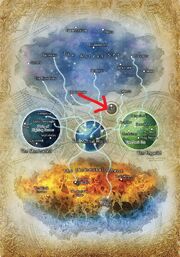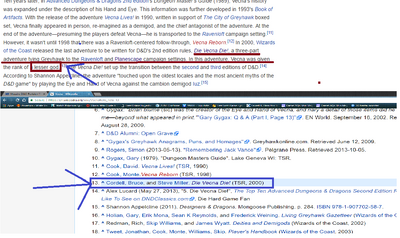- 1,832
- 80
Based off my blog here.
tl;dr
Ao: High 2-A (Superior to Gruumsh and other Greater Deities)
Speed: Immeasurable (exists beyond the concept of time, existed before the construction of the Multiverse)
The Lady of Pain: At Least 2-A, likely higher (Superior to Vecna by an unknown degree, has constantly been portrayed as above other Greater Deities)
Speed: Infinite, likely Immeasurable (can control her own space time, can repair the Infinite Multiverse and could likely survive in it's absence)
Greater Deities like Gruumsh, Lorelion, and Torm: 2-A (Likely comparable to Vecna)
Speed: Infinite (can easily control their own spacetimes and are vastly superior to the deities of time and space beneath them)
Vecna: 2-A (damaged the Infinite Multiverse) (and will link in the description about the Abyss being infinite, which is something Vecna damaged)
Speed: Infinite, possibly higher (Is greatly above the lesser deities who can control spacetime. Was going to potentially destroy the Multiverse and could survive in it's absence)
Lesser Deities: Low 2-C (can control their own spacetimes)
Speed: Infinite (can control their own spacetimes)
Primordials: Ranging between Low 2-C to 2-A at their peak (comparable to other deities)
Speed: Infinite to Infinite, Likely Higher (Comparable to the Deities)
Exarchs and other characters: Varies greatly.
Speed: Varies greatly.
Furthermore: All of the Majority Deities are constantly at war with each other. Bane, Gruumush, Lolth, Torm, etc.
In their employ, they have deities who are capable of fate manipulation, reality warping, death manipulation, time manipulation, casuality manipulation, conceptual manipulation, and more powers.
And, they have resistence to haxes like Soul, Time, Reality, Absolute Zero, and Erasure.
In Favor: 7 (LoyalServantofInti, DragonmasterXYZ, Celestial Pegasus, Azathoth the Abyssal Idiot, Promstein, Darkanime, Antvasima, Aldrecht)
Against: 1 (Deerest of Lords)
Neutral: 1 (EvilMegaCookie)
tl;dr
Ao: High 2-A (Superior to Gruumsh and other Greater Deities)
Speed: Immeasurable (exists beyond the concept of time, existed before the construction of the Multiverse)
The Lady of Pain: At Least 2-A, likely higher (Superior to Vecna by an unknown degree, has constantly been portrayed as above other Greater Deities)
Speed: Infinite, likely Immeasurable (can control her own space time, can repair the Infinite Multiverse and could likely survive in it's absence)
Greater Deities like Gruumsh, Lorelion, and Torm: 2-A (Likely comparable to Vecna)
Speed: Infinite (can easily control their own spacetimes and are vastly superior to the deities of time and space beneath them)
Vecna: 2-A (damaged the Infinite Multiverse) (and will link in the description about the Abyss being infinite, which is something Vecna damaged)
Speed: Infinite, possibly higher (Is greatly above the lesser deities who can control spacetime. Was going to potentially destroy the Multiverse and could survive in it's absence)
Lesser Deities: Low 2-C (can control their own spacetimes)
Speed: Infinite (can control their own spacetimes)
Primordials: Ranging between Low 2-C to 2-A at their peak (comparable to other deities)
Speed: Infinite to Infinite, Likely Higher (Comparable to the Deities)
Exarchs and other characters: Varies greatly.
Speed: Varies greatly.
Furthermore: All of the Majority Deities are constantly at war with each other. Bane, Gruumush, Lolth, Torm, etc.
In their employ, they have deities who are capable of fate manipulation, reality warping, death manipulation, time manipulation, casuality manipulation, conceptual manipulation, and more powers.
And, they have resistence to haxes like Soul, Time, Reality, Absolute Zero, and Erasure.
In Favor: 7 (LoyalServantofInti, DragonmasterXYZ, Celestial Pegasus, Azathoth the Abyssal Idiot, Promstein, Darkanime, Antvasima, Aldrecht)
Against: 1 (Deerest of Lords)
Neutral: 1 (EvilMegaCookie)


